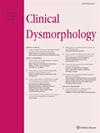刚果民主共和国的脆性X综合征:来自三个家庭的14名受试者的畸形、认知和行为发现
IF 0.5
4区 医学
Q4 GENETICS & HEREDITY
引用次数: 0
摘要
本研究报告了来自3个刚果家庭的14名脆性X综合征患者。男性占多数(8/14),平均年龄18.4(±11.1[14-38])岁。脆性x综合征的典型畸形特征包括面部拉长,耳朵大而突出,在男性和女性中都发现了完全突变。所有青春期后男孩均有大睾丸症。我们队列中的认知能力差异很大,从轻度(智商50-70)到中度(智商35-49)智力残疾(平均智商60)。我们所有的女性病人都有身份证。本文章由计算机程序翻译,如有差异,请以英文原文为准。
Fragile X syndrome in Democratic Republic of Congo: dysmorphic, cognitive and behavioral findings in 14 subjects from three families.
This study reports on 14 individuals with Fragile X syndrome from 3 Congolese Families. The majority (8/14) were males, with an average age of 18.4 (±11.1 [14-38]) years old. Typical dysmorphic characteristics of Fragile-X syndrome including elongated face, large and prominent ears were found in both males and females with the full mutation. Macroorchidism was found in all post-pubertal boys. The cognitive ability in our cohort varies widely ranging from mild (IQ 50-70) to moderate (IQ 35-49) intellectual disability (Average IQ of 60). All our female patients have ID.
求助全文
通过发布文献求助,成功后即可免费获取论文全文。
去求助
来源期刊

Clinical Dysmorphology
医学-遗传学
CiteScore
1.20
自引率
0.00%
发文量
64
审稿时长
6-12 weeks
期刊介绍:
Clinical Dysmorphology publishes succinct case reports on the etiology, clinical delineation, genetic mapping, and molecular embryology of birth defects. This journal covers such topics as multiple congenital anomaly syndromes - with particular emphasis on previously undescribed conditions, rare findings, ethnic differences in existing syndromes, fetal abnormalities, and cytogenetic aberrations that might give clues to the localization of developmental genes. Regular features include original, peer-reviewed articles, conference reports, book and software reviews, abstracts and summaries from the UK Dysmorphology Club, and literature summaries.
Submitted articles undergo a preliminary review by the editor. Some articles may be returned to authors wihtout further consideration. Those being considered for publication will undergo further assessment and peer-review by the editors and those invited to do so from a reviewer pool.
 求助内容:
求助内容: 应助结果提醒方式:
应助结果提醒方式:


